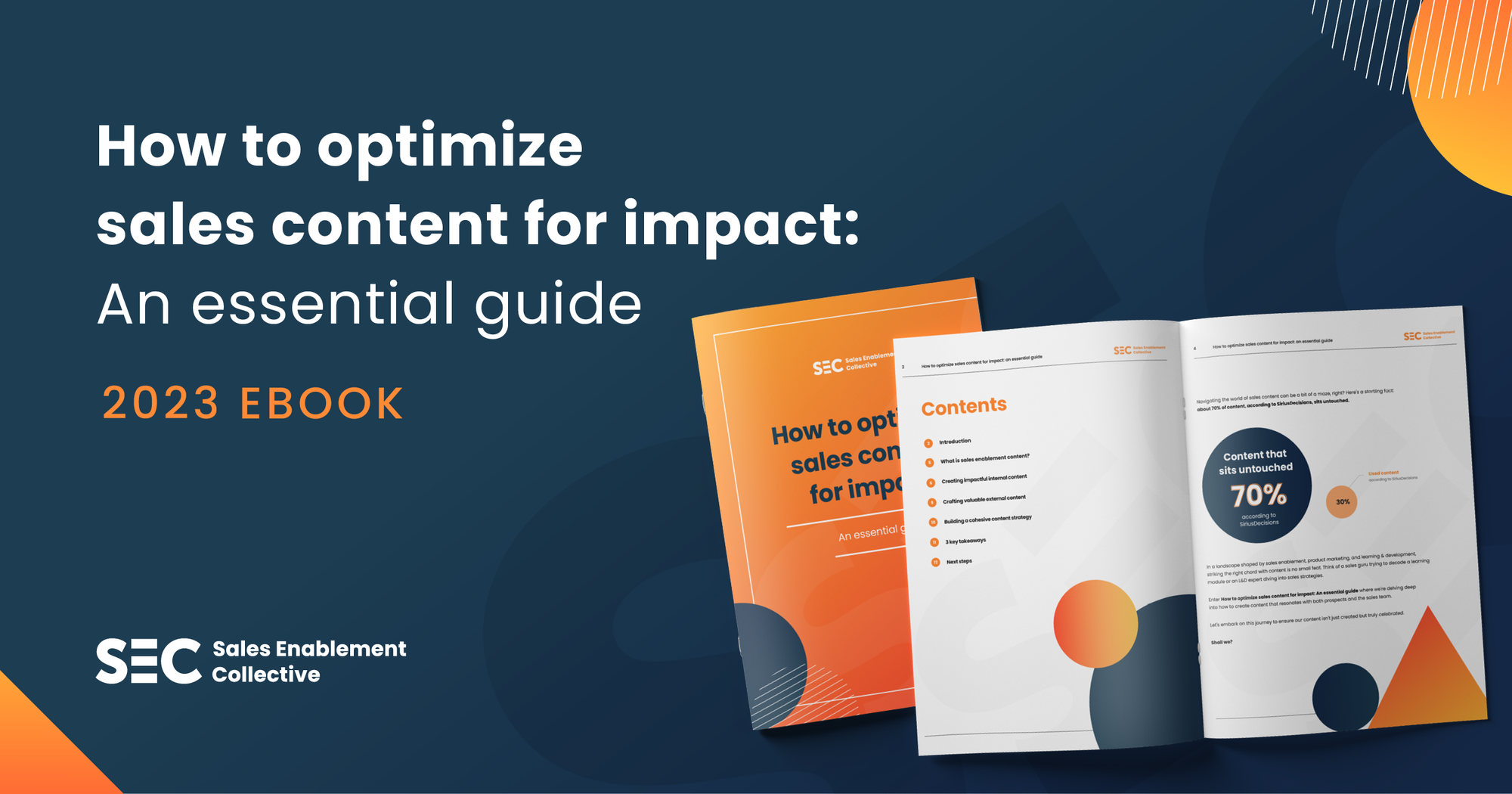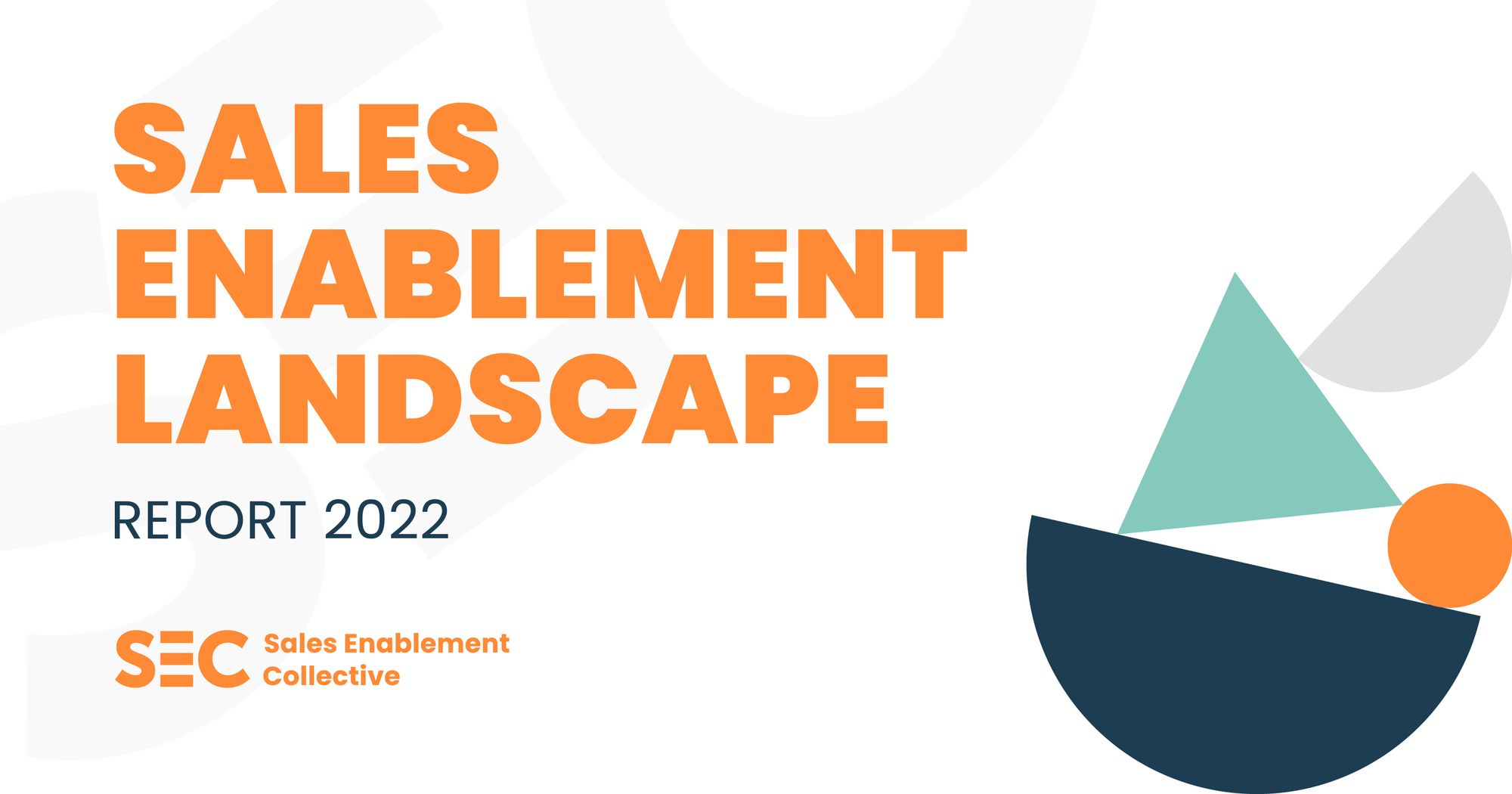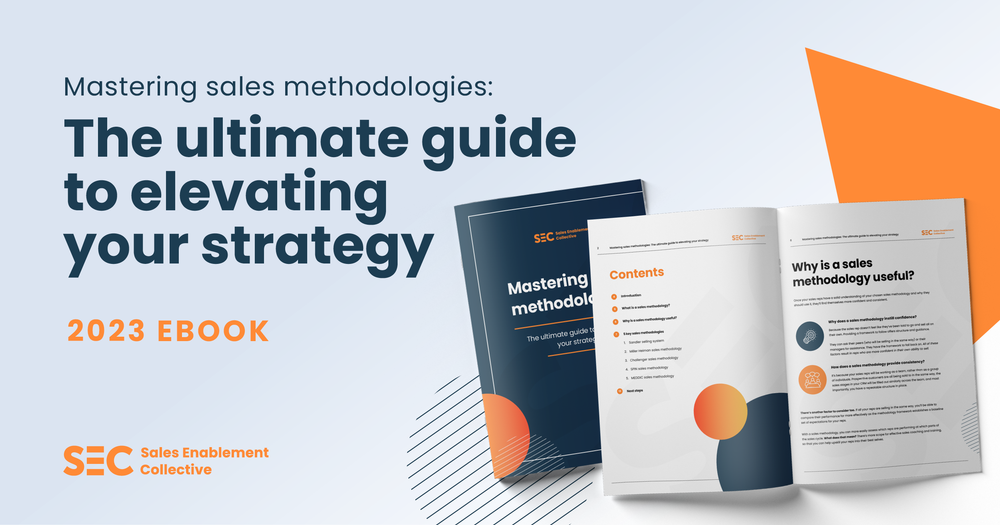Sales enablement is bigger than ever, and with its current trajectory, it’s only heading in one direction: up. As a result, there’s an influx of people taking up sales enablement positions.
One of the great things about enablement is that it can attract people from so many different backgrounds, such as the sales team itself, product marketing, learning and development, marketing, and more.
By its nature, sales enablement encompasses so many elements that it can be hard to pick them up. Someone with a sales background may have more to learn when it comes to enablement’s learning and development aspects, and vice versa.
In this article, we’re going to be focusing on sales enablement content, both internal and external-facing. We’ll cover:
- What internal sales enablement content is
- What external sales enablement content is
- Creating great sales enablement content
- Creating a sales enablement content strategy

But what exactly is sales content? 👇
Simply put, sales content contains information for either a sales professional or prospective customer to view, which provides them with a better understanding of your product/service.
It’s content that a sales rep uses during the sales process to convince a prospect of the product/service’s value.
Let’s begin by covering the two main types of sales enablement content: internal-facing and external-facing:
What is internal sales enablement content?
Internal content is content that is intended for use by an organization’s own sales reps. The goal of any internal content strategy is to provide reps with a greater knowledge of their product portfolio.
This internal-facing content will reinforce the messaging of sales enablement’s coaching and training programs, as well as give reps a consistent source of truth regarding the product.
It’ll put the product/service into context and encourage them to imagine how the product could be implemented within a business.
Internal content can take many forms.
The classic examples include battlecards that provide answers to common customer questions and explain competitive differentiators, objection-handling sales scripts that address common customer pushbacks, and short videos that keep key training points front-of-mind.
But really, there’s no limit to the shapes that internal content can take, as long as it can communicate its key message to reps effectively.

What is external sales enablement content?
It doesn’t matter what you call it. Whether it’s external content, customer-facing content, sales content; it exists and it’s important.
External content can be owned by various departments aside from sales enablement, such as marketing or product marketing.
However, sales enablement should absolutely have input because this content exists to support reps as they work to close a sale, and that’s definitely in the sales enablement wheelhouse!
This type of content includes assets that customers can take away to read/watch in their own time. It shouldn't state the obvious - if content is going to be presented to a customer it has to offer real value, and not waste their time.
Examples include:
- Detailed industry reports which offer insights that prospective customers can apply to their own work and back up the points reps already discussed in conversation.
- Explainer videos that allow prospects to put your product/service into context and help them understand how it would benefit their company before you have further discussions
- Case studies or testimonials that provide evidence and reassurance of the real-life value you can provide (and have provided to previous customers).
One important note is that sales content, regardless of who the target audience is, should be tailored to each step of the sales process. You can’t use the same content during the early stages of the buyer journey as you do right before closing a sale.
Part of sales enablement’s job is to ensure that content covers each part of the process.

Creating great sales enablement content
Creating sales content is time-consuming, but the rewards for getting it right are really big. Internally and externally, great content enhances your reps’ ability to sell and is a key aspect of an effective sales enablement strategy.
From an outside perspective, well-coached reps who have taken internal content to heart and use external content effectively look professional and paint your organization in a good light.
Still, that doesn't change the fact that creating content is time-consuming. If your content isn’t good, and you don’t get the reward after putting in all that time and effort, you’ve got an issue.
Therefore ensuring that your content is of high quality is very important. But how do you actually create great content?
Creating internal sales enablement content
We’ve covered how to create content that sales reps will actually want to use more in-depth before at SEC, but we’ll run over it in this article as well.

Involve multiple parties
When you’re producing content that’s intended for internal use, involve multiple groups in the creation if you can.
Ask the salespeople (the target audience!) what they feel like they need and what they’d like to have on hand as content.
Ask the marketing team and product teams if there’s existing content that can be repurposed and used for sales enablement.
This sort of cross-functional collaboration and two-way feedback helps the sales team feel included, and not like content is just being thrown at them.
This communication is also important in that it ensures the marketing team's messaging is on the same page as the sales team's - meaning less confusion for the prospect as they progress down the sales funnel.
Ask yourself what problem you're solving
Another consideration is this: what problem are you trying to solve?
Have you noticed that your reps struggle to differentiate you from competitors? Then you have to keep that at the forefront of your mind as you create content. Make sure this piece of content specifically targets that problem you want to solve.
A single piece of content can’t be a seller’s bible that addresses every single issue that could ever pop up.
Focus on solving one problem at a time and you’ll find more success than trying to cram every answer into one piece of content.

Creating external sales enablement content
External content broadly has the same role as internal content, which is to help sellers sell more effectively. The key with customer-facing content is to ensure it has real value not just to your rep, but to the prospect as well.
Consider the full buyer journey
We’ve seen the statistics. It used to be that sales was seller-centric, but now the buyer can be up to 60% of the way through the buyer journey before your organization even makes contact.
They probably know about you, before you know about them.
What does that mean for the content that you want to provide to prospects?
It absolutely has to be more than general information about your product/service. It needs to be more than what the prospect can pull up in under two minutes in a web browser.
To create good customer-facing content, one of the most important aspects is to put yourself in their shoes. If you were interested in purchasing your product/service, and had shopped around a bit, what would you want to know in more detail?
As we mentioned before, you’d want an industry report that highlights the need for the product/service, you’d want to see it in action and in context.
If you had a genuine interest in a product/service and a rep presented you with a PDF that had some top-level statistics and nothing more, you’d feel a bit disappointed. You’d want more.
So bear that in mind when you’re creating content aimed at prospects. What does a prospect want to have to hand after a first meeting? What do they want to read right before closing the sale?

Creating a sales enablement content strategy
So far, we’ve discussed what sales enablement content actually means, and what to consider when creating a piece of content in a vacuum.
However, in real life, sales enablement professionals have to have a content strategy. This means that rather than just making a piece of content and leaving it there, you instead have a plan and every piece of content is created and stored as detailed by that plan.
While we could write an entire article on content strategy alone, we’re going to touch on some of the most important aspects of creating that strategy below:
Audit your existing content:
We touched on this above, but ensure that auditing your organization’s content library is something you’re doing on a regular basis.
Marketing or another department may have whipped together a really useful piece of content for their own use, but if you’re not auditing the organization’s content you might miss it.
Analyze the content’s performance:
As the old saying goes, information is power. The more you know about which content is being used most often and what content is most effective, the better.
If you’re tracking the content’s performance you can then make adjustments and learn from what works.
Align content to each step of the customer journey:
Again, this is a point we mentioned above but it deserves a spotlight in this section. Tie specific pieces of content to steps in the buyer journey.
This means taking the guesswork away from your sales reps, so that they know exactly what content to use, and when. Knowing when to use content is just as important as having good content.
Create processes to improve content as time goes on:
Just like how sales enablement doesn’t stop at onboarding (and instead continues into “everboarding” and continuous coaching), when it comes to content your strategy must be long-term.
Don’t create the content you need now and never revisit the strategy. As your organization inevitably grows and expands, and the sales landscape changes, you’ll have to create content that will allow reps to create relationships with new buyer personas, and that uses new technology.
It can be as simple as setting up a quarterly review of your sales content to ensure it still hits the mark. But whatever you do, don't be stagnant.
Ensure the sales team knows what to do with the content:
You can make the best content in the world, but if you don’t have proper processes that train your sales team on how to use that content, it’s useless.
You can’t just throw a load of content into the pile and expect reps to use it. Train them and teach them how to use it strategically, situationally, and effectively and then you’ll reap the benefits.
Fill out the form below to get our ebook on how to master sales methodologies. This ebook covers proven sales methodologies to help you close more deals. It’s the ultimate guide to elevating your sales strategy.

In summary
To summarize, let’s answer the question in the title of this article concisely: What is sales enablement content?
Sales enablement content is content which sales reps use to help them sell their products/services as they go through the sales process.
It provides reps with support and answers to common questions, and it provides prospective customers with context and understanding in regards to a product.
While content won’t make a sale for you, it can still be a great help to your reps.


Join 5,500+ of your sales enablement peers in SEC's Slack community and start networking today.




